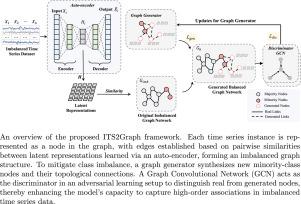ITS2Graph:用于不平衡时间序列分类的基于图的生成对抗学习
IF 6.3
1区 计算机科学
Q1 COMPUTER SCIENCE, ARTIFICIAL INTELLIGENCE
引用次数: 0
摘要
时间序列分类(TSC)是数据挖掘中的一项基本任务,经常受到类不平衡的影响,特别是在实际应用程序中。传统的方法往往无法捕获时间序列之间的高阶内在依赖关系,特别是在少数类样本稀缺的情况下。有效地挖掘这种联系以提高少数族裔的代表性仍然是一个重大挑战。为了解决这个问题,我们提出了ITS2Graph,这是一个基于图的生成对抗学习框架,利用高阶关联来进行不平衡时间序列分类。利用自编码器提取时间序列的潜在表示,在此基础上计算两两相似度构建图,从而将TSC重新表述为节点分类任务。为了减轻类不平衡,图生成器综合了少数类节点特征及其拓扑连接,而图卷积网络(GCN)鉴别器被训练以区分真实节点和生成节点。在22个真实时间序列数据集上的实验结果表明,ITS2Graph在不平衡时间序列分类任务中优于现有算法。本文章由计算机程序翻译,如有差异,请以英文原文为准。

ITS2Graph: Graph-based generative adversarial learning for imbalanced time series classification
Time Series Classification (TSC) is a fundamental task in data mining and often suffers from class imbalance, particularly in real-world applications. Traditional methods often fail to capture high-order intrinsic dependencies among time series, especially when minority class samples are scarce. Effectively mining such associations to improve minority-class representation remains a significant challenge. To address this issue, we propose ITS2Graph, a graph-based generative adversarial learning framework that exploits high-order associations for imbalanced time series classification. An auto-encoder is employed to extract latent representations of time series, based on which pairwise similarities are computed to construct a graph, thereby reformulating TSC as a node classification task. To mitigate class imbalance, a graph generator synthesizes minority-class node features and their topological connections, while a Graph Convolutional Network (GCN) discriminator is trained to distinguish real from generated nodes. Experimental results on 22 real-world time series datasets demonstrate that ITS2Graph outperforms existing algorithms in imbalanced time series classification tasks.
求助全文
通过发布文献求助,成功后即可免费获取论文全文。
去求助
来源期刊

Neural Networks
工程技术-计算机:人工智能
CiteScore
13.90
自引率
7.70%
发文量
425
审稿时长
67 days
期刊介绍:
Neural Networks is a platform that aims to foster an international community of scholars and practitioners interested in neural networks, deep learning, and other approaches to artificial intelligence and machine learning. Our journal invites submissions covering various aspects of neural networks research, from computational neuroscience and cognitive modeling to mathematical analyses and engineering applications. By providing a forum for interdisciplinary discussions between biology and technology, we aim to encourage the development of biologically-inspired artificial intelligence.
 求助内容:
求助内容: 应助结果提醒方式:
应助结果提醒方式:


